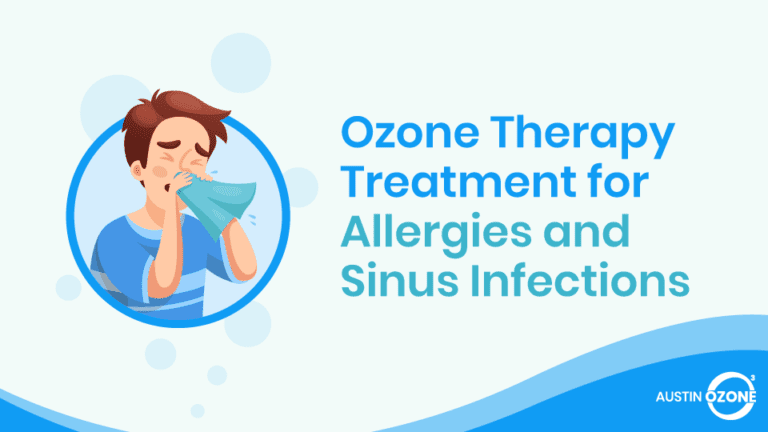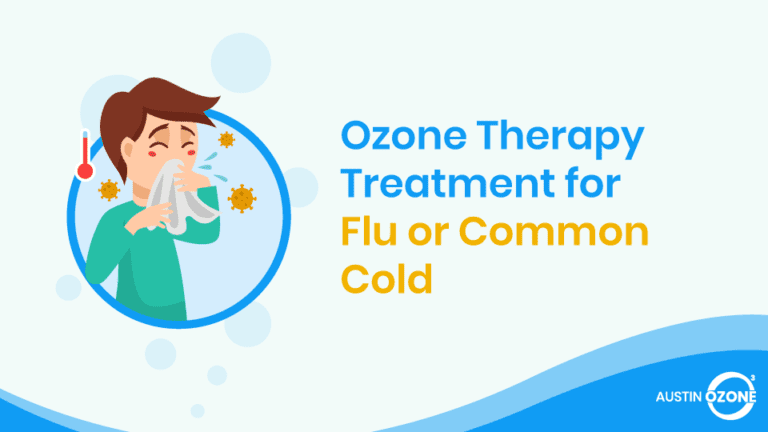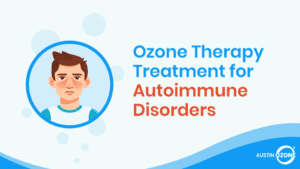Allergies and sinus infections are similar in that they both cause the sinus cavities a significant amount of pain and pressure. Sometimes, severe allergies can eventually lead to sinus infections when ignored.
People with allergies and sinus infections suffer greatly, so various forms of treatment are necessary to relieve their pain. Ozone therapy for allergies and sinus infections is one of them.
Schedule an Ozone Therapy Session Today!
Understanding Allergies
An allergy is not a disease or illness caused by pathogens. Rather, it is an immunological response to foreign substances that are not usually harmful to the body (i.e., certain types of food, pollen, etc.).
The immune system is responsible for keeping the human body healthy by fighting off what it perceives as a threat. In the case of allergies, the immune system wrongfully perceives a foreign substance as a threatening invader and attacks it.
Allergies can develop at any point in a human’s life. Even if you do not have any allergy during childhood, it is still possible for you to develop them as an adult.
During allergic reactions, the immune system releases a chemical known as histamine. Histamine prompts the body to respond accordingly in the form of sneezing, coughing, and other symptoms related to allergies.
Typical Causes of Allergies
Food allergies seem to be the most common cause of an allergic reaction. It usually triggers hives, swelling, rashes, nausea, and more. It is also possible for some to experience an anaphylactic reaction, leading to a difficulty in breathing, lightheadedness, and eventual loss of consciousness.
Other causes of allergies include a change in season. For example, hay fever often begins in early springtime, as various forms of pollens are more common during this period. Susceptibility to allergies can also be passed down from parents to children. However, this doesn’t mean that just because your parent is allergic to shellfish, that you will be too.
Understanding Sinus Infections
Sinus infection2, also known as sinusitis, happens when the sinuses become infected with bacteria, virus, fungi, or mold. Four pairs of sinuses can be found inside the human skull. They are lined with a thin mucus layer that has tiny hair-like projections, which sweep and trap dust and other foreign particles from the air you breathe.
A sinus infection happens when a germ blocks the mucus from draining, thereby causing an inflammation in the lining.
The symptoms of sinus infection are not that different from a bad cold or an allergic reaction, which can make it quite hard to diagnose. Since a sinus infection is caused by germ infection, the treatment for it often includes antibiotics. It is important to treat an infection as soon as possible because of the sinuses’ proximity to the brain.
There are two types of sinus infection: acute and chronic. Most cases of acute sinus infection start with a common cold. On the other hand, people who have allergies or asthma are more likely to suffer from chronic sinusitis8.
Typical Causes of Sinus Infection
A bacterial infection is often the cause of a sinus infection. Still, there are several factors that can increase the probability of acquiring a sinus infection. These include allergies, a previous cold, smoking or exposure to second-hand smoke, presence of nasal polyps, and a weak immune system. It is also possible to get a sinus infection from dental diseases4.
If the sinuses get blocked for a long time, you can get a secondary infection, which can stay in the respiratory tract. These bacteria will multiply and can cause a more serious health condition.
Difference Between Allergies and Sinus Infection
Those who are suffering from allergic reactions often experience symptoms1 of sneezing, headaches, rashes, itchy and watery eyes, and cold-like symptoms. While it is possible to experience the same symptoms for sinus infection as those for allergic reactions, sinus infections can also cause pain around the cheeks and eye area, as well as lead to fever and bad breath, and produce a thick, discolored discharge or mucus.
Allergies often appear without warning whereas a sinus infection often follows after suffering from a cold or a viral infection.
A doctor can diagnose whether you are suffering from an allergic reaction or a sinus infection by performing a physical examination, considering your medical history, and asking about the symptoms. They can further recommend a CT scan and an endoscopy to determine if you are suffering from sinusitis.
Why You Need to Worry?
Depending on the severity, both allergies and sinus infection can be life-threatening. They can lead to restricted breathing, increase in heart rate, and sudden swelling of the tongue and mouth. Allergies can make an existing respiratory condition, like asthma and bronchitis, worse.
For sinus infections, the symptoms can drag from days to months. Because of its location, infection in the paranasal sinuses can also lead to bone and eye infection, meningitis, thrombosis, and brain abscess.
Traditional Treatment Methods for Both Allergies and Sinus Infections
Allergies and sinus infections often get better on their own. However, they can still be an inconvenience.
For people with allergies, the best way to prevent a reaction is to stay away from the known triggers. If it is not possible, standard treatment for allergies include taking antihistamines or corticosteroids to control the symptoms. Some people choose to undergo immunotherapy to prevent the allergies altogether.
For sinus infection, standard treatment always includes unblocking of the nasal passages. This helps the sinuses drain or flush out the infection. To do this, some opt to do steam or nasal irrigation using warm salt water. There are also nasal and oral steroids that you can take to reduce any swelling or inflammation.
Doctors may prescribe antibiotics to fight bacterial infection. Unfortunately, some antibiotics can have side-effects and even lead to antibiotic resistance, which can worsen the infection. In extreme cases, they recommend getting a sinus surgery to finally open up your blocked sinus.
Ozone Therapy for Allergies and Sinus Infections
A medical ozone generator3 is an allotrope of oxygen, produced by running pure oxygen through ozone. Because of its chemical nature, ozone is well-known for its potent oxidation properties. This helps resolve infections3, as it helps increase the production of cytokines, a group of proteins secreted by the immune system to regulate immunity and inflammation. Medical ozone can also help neutralize allergens that cause an allergic reaction.
There are different ways to administer ozone to the body. Most infections can be alleviated by undergoing Major Autohemotherapy (MAH)7 where the patient’s blood is infused with medical ozone gas. However, for sinus infection and allergies, it might be better to choose insufflation through the ears or nose as treatment to introduce the gas directly to the infected areas.
For sinus infection and allergies, it might be better to choose insufflation through the ears or nose as treatment to introduce the gas directly to the infected areas.
Insufflation is the act of pumping a specific dose of medical ozone gas8 into the body through crevices like the ears or the nose. The ozone gas is run through both ears (or both nostrils) via a special stethoscope or cannula for a few minutes a day6.
This process is virtually painless, noninvasive, and can bring immediate relief. For sinus infections from dental issues, an ozone injection directly to the soft gingival tissue or at the base of the infected tooth should do the trick.
Ozone therapy can also be used to drain inflamed sinuses. This often includes washing the sinuses by aeration using ozonated saline water.
Summary
Allergies and sinus infections are both respiratory conditions that exhibit similar symptoms, although they are triggered by different things.
Normally, allergic reactions and sinus infections can get better on their own without requiring any treatment. However, the symptoms do not go quietly and may stay for more than a few days if left untreated, and sinus infections can develop into serious health complications.
While prevention is always better than cure, sometimes it is not possible because you may not be aware that you are allergic to a substance you were unwittingly exposed to. It’s also possible that an old illness (like a previous cold) has made your sinuses vulnerable to infection-causing bacteria, virus, or fungi.
Ozone therapy offers a fast, effective, safe, and cost-effective method for alleviating both allergies and sinus infections.
There are many treatments available in the market for allergies and sinus infections. However, most are costly and can only provide temporary relief.
Ozone therapy offers a fast, effective, safe, and cost-effective method for alleviating both allergies and sinus infections. Unlike other modes of treatment, ozone therapy has no known side-effects, and it can effectively destroy the root cause of allergies and sinus infection. Not only can its oxidative properties eliminate bacteria, virus, and fungi, but it can also strengthen the immune system.
Schedule an Appointment Today
References
- American College of Allergy, Asthma, & Immunology. (n.d.). Allergies. Retrieved from https://acaai.org/allergies
- Institute for Complementary & Alternative Medicine. (n.d.). Sinus ozone. Retrieved from https://icamnj.com/therapies/sinus-ozone/
- Institute for Progressive Medicine. (n.d.). Ozone therapy. Retrieved from Institute for Progressive Medicine: https://www.iprogressivemed.com/ozone-therapy-2/
- Kim, S. (2019). Definition and management of odontogenic maxillary sinusitis. Maxillofacial Plastic and Reconstructive Surgery, 41(1), 13. doi: 10.1186/s40902-019-0196-2
- Monarch Integrative Health. (2020, January 13). Ozone helps sinus congestion. Retrieved from https://www.monarchintegrativehealth.com/blog-feed/2020/1/13/ozone-helps-sinus-congestion
- Pyper, L. (2015, December 14). How Ozone Therapy can help with Sinusitis. Retrieved from https://salvagente.co.za/ozone-saunas/how-ozone-therapy-can-help-with-sinusitis/
- Transcend Dental Health. (2020, April 29). Dental and integrative services. Retrieved from https://www.tdhtx.com/services/dental-and-integrative-services
- Young, K. (2019, May 2). The healing power of ozone. Retrieved from https://thriveglobal.com/stories/the-healing-power-of-ozone/






